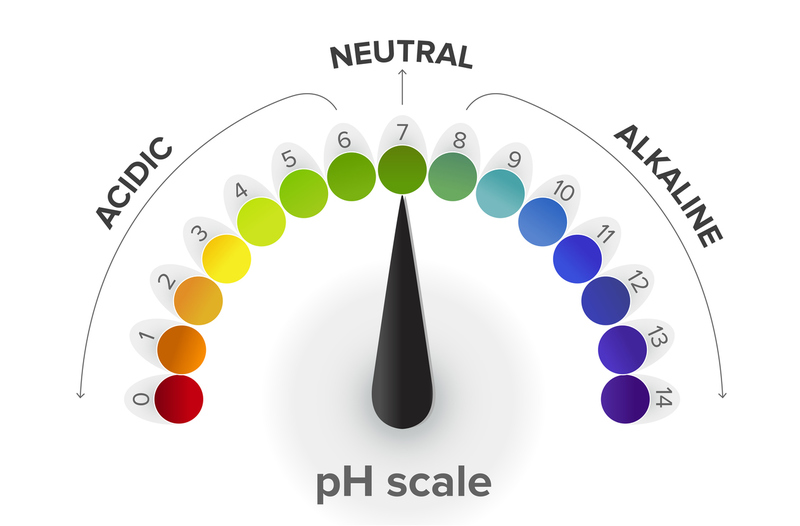Why acid-base balance is important for your health?


How to do it and to know if you are more acidic than alkaline?
This is the topic for you, your mind and body!
I’ve been following an Ayurvedic diet for years now. This diet has allowed me to feel much better with greater energy and better digestion, however However, I need to be vigilant because of the seasons and my Ayurvedic constitution.
I’m mostly Vata-Pitta and if I’m not careful I can suffer from heartburn and reflux. These symptoms can appear when I am in a hot environment and I manage to rebalance with food.
I also practice specific breathing exercises to avoid all this. I’ll tell you about it a bit below.
Acid-base balance: the principle
The concept of acidity or alkalinity is linked to the pH (potential Hydrogen). You may remember your high school chemistry class: pH is measured on a scale of 0 to 14.
7 is neutral pH; above 7: the pH is basic or alkaline; below 7: the pH is acidic.
This scale is logarithmic: the change of one pH unit implies that the acidity or the alkalinity is multiplied by a factor of 10. Thus a water of pH 6 is ten times more acidic than a water of pH 7; pH 5 water is 100 times more acidic than pH 7 water.
Blood is slightly basic with a pH between 7.35 and 7.45. The stomach is very acidic, with a pH around 3.5, which allows it to dissolve food. The pH of the urine varies according to what you have eaten, this is what allows, among other things, to balance the blood pH. If the pH of the blood becomes too acidic, the body will draw on these mineral stores from the organs and bones to neutralize the acidity.
So too long an acid state condition can go undetected for years, while slowly doing damage.
A very small pH fluctuation towards acidity and symptoms of acid-base imbalance will appear: runny nose, chronic colds, more fatigue, more difficult digestion, joint pain, dry skin, acid reflux , canker sores, brittle nails and hair…
Thus, having bodily fluids in an alkaline state is what is aimed for in order to have optimal health.
What are the benefits?


The benefits are:
- Increased oxygen levels
- More efficient immune system
- More supple, younger-looking skin
- Improved quality of sleep Higher
- energy levels
- Better digestion
- Healthy bones
- Greater clarity Mental
- Joints Without Pain
One way to tell if you are too acidic is to measure the acidity of your urine or saliva with test strips. They are easily available in all pharmacies.
How to make your diet alkaline


All the foods we eat produce after digestion a basic or acidic residue which is released into the blood. Our blood must be kept strictly within a certain range of the pH scale: a deviation of 0.2 towards acids can be fatal. Thus, if we consume too many acidifying foods, to maintain the acid-base balance, hormesis mechanisms are triggered to alkalize the blood by recovering nutrients from the organs.
Alkaline versus acid
It is necessary to take care on the one hand, to consume enough alkalizing foods, on the other hand, to avoid consuming too many acidifying foods, under penalty of seeing this precious reserve diminished.
Having a sufficient amount of basic nutrients is essential for the balance of body pH.
The modern diet includes a very high proportion of acidifying foods such as proteins, cereals, processed and sugary products. Plus the consumption of coffee and alcohol and this creates a strongly acidifying ground.
And fruits and vegetables, which are alkalizing, are often in insufficient portions to restore the balance.
The alkaline character of a food is what results from it after its digestion: thus a fruit with an acid taste like lemon is generally considered to be alkalizing because it provides alkalizing minerals to the body.
Metabolism role
However, a person’s metabolism also comes into play: if a person’s metabolism is inefficient, acidic foods will have an acidifying action.
An alkaline food will form a significant amount of basic minerals such as: potassium, magnesium, calcium, manganese, iron…
An acidic food will form a significant amount of acidic minerals such as: chlorine, sulfur, phosphorus, nitrogen ,…
Acidifying foods are typically denser and more difficult to digest. They are anabolic foods, tending to be stored more easily. While alkalizing foods will have a cleansing and detoxifying effect.
Among acidic foods, we can also distinguish between strong acids and weak acids:
Strong acids need to be associated with minerals such as sodium, potassium, magnesium or calcium to be digested.
Weak acids such as acetic acid that can be found in vinegar or most fruits can combine with water to form carbonic acid which will then be expelled as carbon dioxide through respiration. These foods also contain alkaline minerals, which will be the residue carried in the blood. They are therefore alkalizing.
However, this may depend on the person’s metabolism, as we mentioned above: in the event of metabolic weakness, they may also create acid residues. This is the case for tomatoes, lemons, vinegar, honey, rhubarb, etc.
The main acidifying foods are:
- Foods rich in protein: red meat, egg whites
- Refined foods
- Cheeses, particularly fermented cheeses
- Sodas, coffee, alcohol
- Legumes
- Nuts (all varieties except almonds and Brazil nuts)


The main alkalizing foods are:
- Citrus fruits
- Spinach
- Avocados
- Celery
- Garlic
- Ginger
- Bananas blackberries
- Sprouted seeds
- Seaweed
- Potatoes
- Chestnuts
If you have trouble keeping the balance on your plate, you can also put the odds in your favor by filling your glass with alkaline water.
You can buy it directly from the store or make it yourself by adding a pinch of Himalayan salt or baking soda.
Don’t mix everything : food incompatibility:
Modern science continues to validate Ayurvedic wisdom a little more every day. And the question of food compatibility is no exception to the rule. Here is what the rishis, our grandmothers and the scientists recommend to us.
First of all, I would like to remind you that Ayurveda does not recommend drastically changing your habits overnight. It is wise to know the principles to observe how they affect our daily lives and know how to correct when we feel the need. Self-knowledge combined with Ayurvedic knowledge is a process that begins with observation.
The most important: your digestive fire
The importance of the right food combinations lies in the vital role of our digestive fire. Agni, the fire, is what animates us, what transforms our energy into action and what illuminates our intellect. A weak digestive fire creates disorders such as gas, bloating, indigestion; and when we feed it badly, it gets worse until it creates a form of fermentation and putrefaction in our digestive system.
Once our digestive system is polluted, it pours the surplus into our body and this creates disease. It is therefore necessary to take care to maintain a strong digestive fire and to give it the fuel adapted to its capacity.
There are many tricks to fortify your digestive fire such as adding herbs and spices, or eating fresh ginger before the meal, or even drinking a few sips of hot water at the table. But the main thing to maintain a healthy digestive system and good health is to follow a diet adapted to your constitution: the Pitta types, an anti-Pitta diet, the Vata types, an anti-Vata diet and the Kapha types, an anti-Vata diet. anti Kapha.
For all constitutions, the rules of Ayurvedic food combinations are the same. The right combinations are those that our digestive fire has the best ability to transform into positive energy, those that won’t stay on our stomachs, burn it or gasify. Here they are:
Fruits
Because they are digested very quickly, fruits should be eaten alone. The rule is 30min before meals or 3 hours after.
Cereals
Combine with everything except fruit and milk.
Vegetables
Go well with everything except fruit, nuts and milk.
Beans and legumes
Go well with cereals and vegetables.
Solanaceae (potatoes, tomatoes, eggplants, peppers). Do not mix with cucumbers or with any dairy product.
Nuts
To be eaten alone, or with cereals only.
Milk
It is better to consume it alone, outside of meals. It still combines quite well with dates, almonds, and in porridge.
Butter and Ghee
Universally Combinable. Exception of ghee with honey, which only combine in different proportions.
Yoghurt and Cheese
Pair with cereals and vegetables only.
Animal proteins
Consume with green vegetables and cereals only. Above all, do not mix the proteins together.
Other useful tips:
– Avoid raw and cooked foods in the same meal
– Cooking foods together improves their ability to combine with each other
Be vigilant, be flexible, be creative
Use your breath


Another method to alkalize your body fluids is breathing.
Carbon dioxide is acidifying. Breathing deeply will lead to better oxygenation and lower carbon dioxide levels in the blood.
A very effective technique for implementing alkalizing breathing is the Wim Hof method.
This method is based on 3 pillars:
- Breathing exercises
- Exposure to cold
- Strengthening the mind
Here is the method:
- Sit or lie down in a comfortable position
- Take 30 deep breaths, filling your belly with oxygen, your lungs, your head, to the max.
- On the last breath, exhale and hold your breath, lungs empty.
- Stay as long as possible
- Inhale and hold your breath, lungs full for 15 seconds
- Repeat the cycle 2 more times.
This way of breathing increases the pH by reducing the level of carbon dioxide.
This breathing cycle makes it possible to significantly increase the holding time with empty lungs.
Indeed, this cycle begins with hyperventilation. However, hyperventilation drastically reduces the level of CO2 in the blood.
At the beginning of empty lung retention, we start with very low CO2 levels. However, one of the main activators to catch your breath is the level of CO2. According to some physiologists, 80% of the need to breathe comes from high CO2 levels and 20% from low O2 levels.
A high blood pH level results in a hyper-excitable state of the nervous system. It provides a feeling, often unpleasantly connoted, of loss of control, similar to what one can experience during an anxiety attack.
It is also an opportunity to show oneself that one is capable of inducing this state oneself, of activating it as well as deactivating it.
Take action on your lifestyle


Our way of life is also important when it comes to restoring an acid-base balance. We have seen the importance of oxygenation.
- Do physical activity
- Minimize stressful situations as much as possible
- Take regular “breaks” for breathing, pranayama
- Get enough sleep
- Eat slowly and chew your food well
Practicing yoga is an excellent way to act on your relationship to stress and activate the parasympathetic system.
By the importance given to breathing, yoga can oxygenate the tissues in depth.
Poses in flexions, like the Inverted Triangle, Ardha Matsyendrasana, the crocodile,… where certain organs are compressed will highlight the role of the breath, especially if one concentrates on a visualization of the breath in the solar plexus and throughout the belly when taking these postures.
On the Pranayama side, it is the breaths of Kapalabhati and Nadi Shodhana that will be particularly indicated.
Kapalabathi will act on the hyperventilating side. It is a breath that brings a lot of oxygen and cleans the respiratory system.
While Nadi Shoddhana is a very calming and soothing breath for the mind.
Here are some other ideas for breathing techniques:
Lengthen the times of expiration and inhalation and put all your intention into every movement you make. Try to feel the space created in your body, feel your lungs expand and your whole body become more fluid.
Finally, to solidify your bones, perhaps demineralized by an overly acidifying diet, more anchored and stronger postures such as:
- The tree Vriksasana
- The crow bakasana
- The Warrior Virabhadrasana
- combined with a breath of Bhastrika to increase the oxygenating effect, will be beneficial to build a good foundation.
The Ayurvedic perspective
Ayurveda places great importance on food. If you follow me on the podcasts you know that this one is adapted to each individual, according to his Dosha.
If we eat seasonal, fresh, unprocessed and non-industrial foods, this balance will occur naturally.
I do not recommend fermented cheeses which are very acidifying.
Using spices is also very important, on the one hand for their therapeutic effects and on the other hand will allow to reach a basic pH: thyme, cumin, cinnamon, turmeric… This makes the plate come coloured, pleasant to the eyes and to the taste.
Among these spices a particular note for ginger, particularly alkalizing.
By following the precepts of Ayurvedic cuisine, even independently of your Dosha, you will naturally tend towards a more basic diet.
Also take the time to enjoy each food.
Sattvic, Rajasic and Tamasic food
We will also favor sattvic foods, with a little rajas food and very little tamas.
- sattva: which brings harmony, purity, truth, beauty, calm
- rajas: change, energy, passions, strength, desire, ego
- tamas: attachment, darkness, darkness, heaviness , inertia, coldness.
So,
- sattva could be related to the alkaline state,
- rajas could be related to the neutral state,
- tamas could be related to the acid state.
The sattvic state is a state of harmony, purity and inner peace. In this state, we are inspired, focused, we feel joy, contentment, love.
Our body feels light and full of energy. We master it perfectly. We give without expecting anything in return. A fulfilling life is a life where sattvic moments are predominant.
The sattvic quality can be infused differently:
- by practicing sattvic activities: such as meditation or yoga
- by adopting positive thoughts
- by walking in a sattvic environment: a lake, a forest, …
- by surrounding oneself with people who are sattvic dominant: calm and benevolent
- by adopting a sattvic diet:
* The following foods are considered sattvic: fresh fruits and vegetables, dairy products of biological origin, nuts, vegetables, honey, oils (note that nuts, honey, dairy products are considered acidifying).
* Preparation is also important: the meal must have been freshly prepared and with a loving intention. Food must not have been made in a process that is harmful to the environment, animals or human beings.
One can see the parallels between the pursuit of the sattvic state and the alkaline state.
Conclusion
I always favor sattvic foods and eating in calm and gratitude.
Even if Ayurveda advocates advice to apply that makes sense for everyone, regardless of Dosha.
The general recommendations are very interesting: get oxygen more often, reduce your stress level, do breathing exercises…
In short, return to a more basic way of life!
Take care. Hari Om.
References
Understanding Acid-Base Disorders
Acid Balance, Dietary Acid Load, and Bone Effects
The therapeutic importance of acid-base balance
